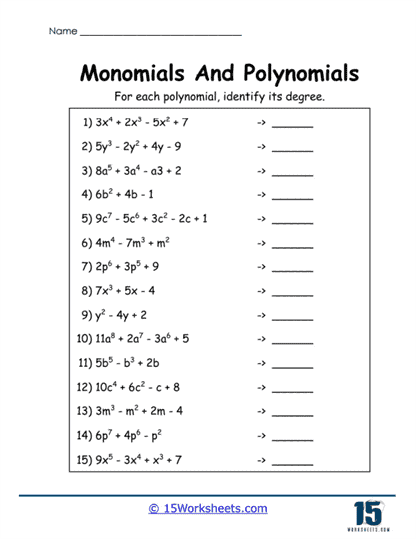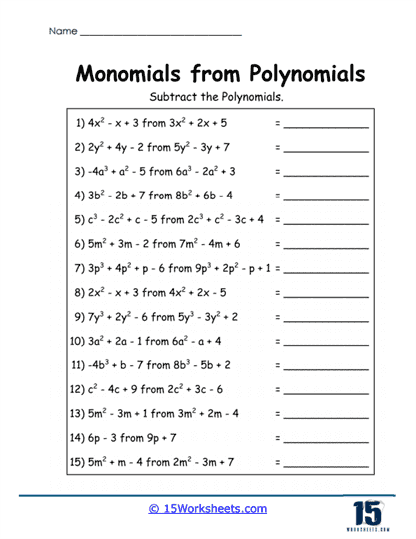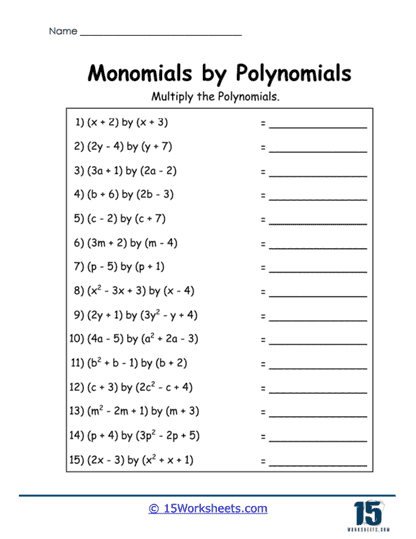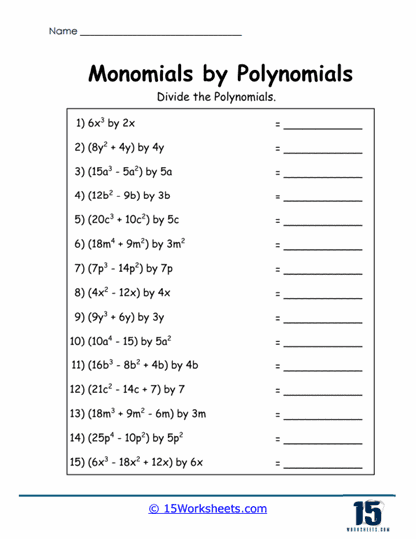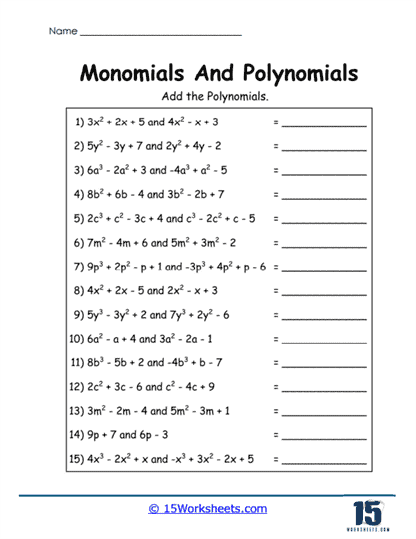Monomials And Polynomials Worksheets
All About These 15 Worksheets
This worksheet collection is a comprehensive resource designed to enhance students’ understanding of algebraic expressions. These worksheets are ideal for students, teachers, and homeschoolers, providing a structured and engaging approach to mastering monomials and polynomials. Each worksheet is available in PDF format, making them easy to download, print, and use in both classroom and home settings. The PDF format allows for flexibility, whether you prefer to review the worksheets on a screen or have a physical copy for practice.
The worksheets in this collection cover a broad range of algebraic topics, particularly focusing on monomials and polynomials, which are foundational in understanding more complex algebra. The activities in these worksheets are designed to engage students with a variety of tasks, from identifying monomials and polynomials to performing operations like addition, subtraction, multiplication, and division. This comprehensive approach ensures that students can progressively build their algebra skills, step by step.
A Look At Our Worksheets
Diving into the whimsical world of Monomials and Polynomials, this delightful worksheet collection will have students whispering sweet nothings to variables and befriending coefficients like old pals. At the very start of their algebraic journey, students are gently eased into the concept with “Mono or No?“ and “Monomial Mixer“-two deceptively innocent-sounding activities that ask students to distinguish monomials from mathematical imposters. It’s like algebraic Tinder: swipe left on expressions with more than one term or nasty negative exponents, and swipe right on pure, well-behaved monomials. The “Mixer” goes a step further, inviting learners to create and sort monomials as if they’re running a polynomial smoothie shop. Banana x², anyone?
Once students have sworn allegiance to the kingdom of Monomia, they march bravely into the land of operations with “Multiplying Monomials“ and “Monomial Division.” It’s here that the real mental gymnastics begin. In a plot twist worthy of a math soap opera, variables get multiplied, exponents get added, and bases that once stood alone find unity. Division, of course, is its own beast-reducing terms and exposing common factors like an algebraic truth serum. These worksheets make students feel like algebraic surgeons, dissecting expressions with surgical precision. Spoiler: it’s all fun and games until someone forgets the quotient rule.
Next up: the intriguing world of polynomial forensics. “Polynomial Identifier,” “Degree Decoder,” and the not-once-but-twice-appearing “Degree Detective“ turn students into polynomial Sherlocks, searching for clues in terms and decoding the degree of expressions with a magnifying glass and a monocle (metaphorically, of course-though monocles are encouraged). These activities focus on structure and classification, prompting deep existential questions like, “Is this really a quadratic, or just a linear equation in disguise?” Degree-related identity crises abound, and the second appearance of “Degree Detective” suggests the case might not be as simple as it first seemed. We may need backup from the Algebra Bureau of Investigation.
Of course, every algebra adventure needs a touch of arithmetic flair. Enter “Subtraction Safari,” “Subtracting Simplicity,” and “Addition Adventure.” These worksheets are as dramatic as their names suggest-an epic quest where terms must align like constellations in the polynomial sky. Students will learn that combining like terms is not just a matter of adding and subtracting but a deeply emotional reconciliation of similar parts. Imagine two 3x²s meeting after years apart, merging into a beautiful 6x²-algebraic poetry in motion. The safari might involve some lions and subtraction signs, but the treasure at the end is simplified expression bliss.
Lastly, things get delightfully puzzling with “Multiplication Maze,” “Division Dive,” “Common Monomial Hunt,” and “Monomial Magic.” These are the gamified gems of the collection, where learning hides behind the mask of adventure. In the maze, students navigate multiplication challenges like Indiana Jones through ancient polynomial ruins. The division dive has them plunging into the deep, searching for answers in a sea of variables. The monomial hunt is a thrilling scavenger challenge, while “Monomial Magic“ suggests some Hogwarts-level algebra happening behind the scenes. Wands optional, but a solid grasp of exponent rules? Absolutely mandatory.
What Are Monomials?
A monomial is an algebraic expression that consists of a single term.
A monomial is a mathematical expression made up of a single term. It has three main parts:
1. Coefficient
The coefficient is the numerical part of the monomial.
It tells you how many of the variables or products you have.
Example: In the monomial 6x2, the coefficient is 6.
2. Variable
The variable is the letter used to represent an unknown value.
It can be x, y, z, etc.
Example: In 6x2, the variable is 𝑥.
3. Exponent (or Power)
The exponent shows how many times the variable is multiplied by itself.
It is written as a small number above and to the right of the variable.
Example: In 6𝑥², the exponent is 2, which means (x * x)
What Are Polynomials?
A polynomial is essentially a sum of multiple monomials. These monomials are called the “terms” of the polynomial, and they are separated by addition or subtraction signs. For example, the expression 3x2 + 2x – 5 is a polynomial with three terms.
Main Parts of a Polynomial
1. Terms
A term is each individual monomial in the polynomial.
Terms are separated by plus (+) or minus (-) signs.
Example: In 4x2 – 3𝑥 + 7, the terms are: 4x2, -3𝑥, and +7
2. Coefficients
The coefficient is the number in front of the variable(s) in a term.
Example: In 4x2 – 3𝑥 + 7, the coefficients are:
4 for x2
-3 for 𝑥
7 is also considered a coefficient (for a constant term)
3. Variables
Letters like x, y, etc., that represent unknown values.
Example: In 4x2 – 3𝑥 + 7, the variable is 𝑥.
4. Exponents
Show how many times the variable is multiplied by itself.
Example: In 4x2 – 3𝑥 + 7, the exponents are:
2 for x2
1 (implied) for 𝑥
The constant term 7 has no variable or exponent.
5. Constant Term
A number without a variable.
It stands alone as its own term.
Example: In 4x2 – 3𝑥 + 7, the constant term is +7.






